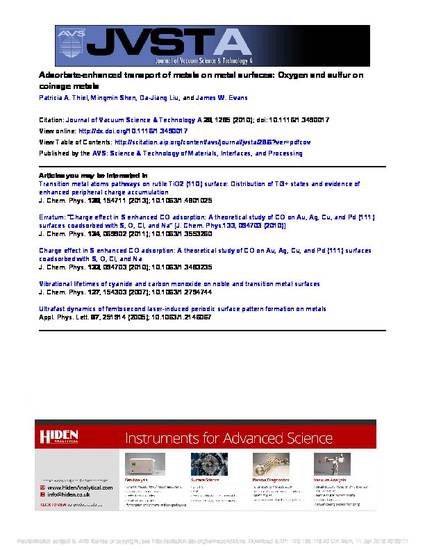
Coarsening (i.e., ripening) of single-atom-high, metal homoepitaxial islands provides a useful window on the mechanism and kinetics of mass transport at metal surfaces. This article focuses on this type of coarsening on the surfaces of coinage metals (Cu, Ag, Au), both clean and with an adsorbed chalcogen (O, S) present. For the clean surfaces, three aspects are summarized: (1) the balance between the two major mechanisms—Ostwald ripening (the most commonly anticipated mechanism) and Smoluchowski ripening—and how that balance depends on island size; (2) the nature of the mass transport agents, which are metal adatoms in almost all known cases; and (3) the dependence of the ripening kinetics on surface crystallography. Ripening rates are in the order (110)>(111)>(100), a feature that can be rationalized in terms of the energetics of key processes. This discussion of behavior on the clean surfaces establishes a background for understanding why coarsening can be accelerated by adsorbates. Evidence that O and S accelerate mass transport on Ag, Cu, and Au surfaces is then reviewed. The most detailed information is available for two specific systems, S/Ag (111) and S/Cu(111). Here, metal-chalcogen clusters are clearly responsible for accelerated coarsening. This conclusion rests partly on deductive reasoning, partly on calculations of key energetic quantities for the clusters (compared with quantities for the clean surfaces), and partly on direct experimental observations. In these two systems, it appears that the adsorbate, S, must first decorate—and, in fact, saturate—the edges of metal islands and steps, and then build up at least slightly in coverage on the terraces before acceleration begins. Acceleration can occur at coverages as low as a few thousandths to a few hundredths of a monolayer. Despite the significant recent advances in our understanding of these systems, many open questions remain. Among them is the identification of the agents of mass transport on crystallographically different surfaces e.g., 111, 110, and 100.
Available at: http://works.bepress.com/james-evans/4/

The following article appeared in Journal of Vacuum Science and Technology A 28, no. 6 (2010): 1285, doi:10.1116/1.3490017.